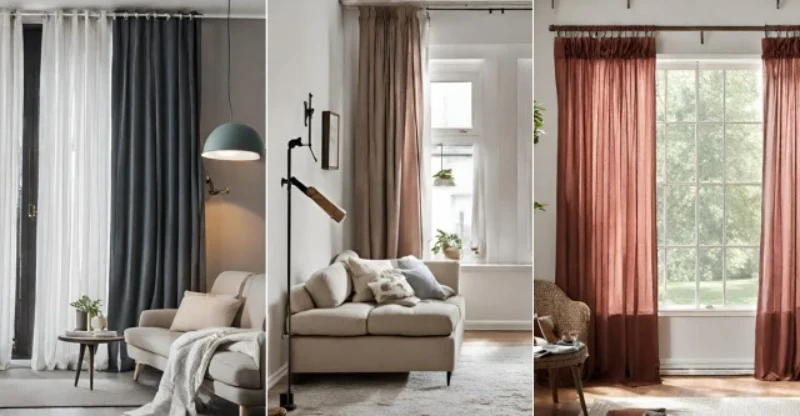5 Ways to Hang Curtains Without Drilling
Hanging curtains is an essential part of home decor. They add style, privacy, and a personal touch to your living space.
However, only some can or want to drill holes in their walls, whether because you’re renting, concerned about damaging delicate wall surfaces, or simply looking for a temporary and flexible solution.
Fortunately, several innovative and effective ways to hang curtains without drilling make it easier to enhance your windows.
This guide will explain various methods, offering step-by-step instructions, tips, and creative alternatives to help you hang your curtains quickly and confidently.
Note: This website is supported by readers and if you click on our links we may earn a commission and as an Amazon Associate, we earn from qualifying purchases.
1. Adhesive Hooks: An Easy Solution
Adhesive hooks offer a versatile, straightforward solution for hanging curtains without drilling holes into your walls. They are ideal for renters or those who prefer a damage-free installation.
To use adhesive hooks effectively, start by selecting the right hooks that can support the weight of your curtains. Choosing hooks labeled for heavy-duty use is crucial if your curtains are thick or lined.
Before installation, clean the wall surface with rubbing alcohol to remove any dirt or grease, ensuring the adhesive will bond properly.
Carefully measure and mark the placement of the hooks to maintain an even height and distance, keeping your curtains level.
Peel off the adhesive backing and press each hook firmly against the wall for about 30 seconds; then, wait at least an hour before hanging your curtains to allow the adhesive to set fully.
Slide your curtain rod through the curtains and place it on the hooks, adjusting the curtains to ensure they hang beautifully.
This method simplifies the installation process and allows easy removal without leaving residue or marks, making adhesive hooks a practical choice for temporary setups and frequent decor changes.
2. Tension Rods
Tension rods are an excellent, tool-free option for hanging curtains, making them ideal for renters or anyone who prefers not to drill into their walls. These rods are particularly suited for lightweight to medium-weight curtains.
To install a tension rod, start by measuring the inside width of your window frame to ensure you select a rod that can extend just beyond this measurement for a tight fit. Once you have the right size, slide the curtain onto the rod and place one end inside the window frame.
Extend the rod until it fits snugly against the opposite side of the frame. For added security, twist the rod to tighten its grip within the frame, ensuring it is straight and firmly in place to support your curtains adequately.
Tension rods are easy to install and adjustable, allowing you to change the height and position to suit different curtain lengths or styles.
This adjustability is perfect for creating layered looks with various curtain types without leaving any marks or damage on your walls.
3. Magnetic Curtain Rods
Magnetic curtain rods are a superb option for those with metal window frames or doors. They offer a straightforward and effective way to hang curtains without installation tools.
To use magnetic rods effectively, start by selecting a rod with magnets that are strong enough to support the weight and type of your curtains.
It ensures that the curtains will hang securely and not slip. Once you have the appropriate rod, position it against the metal frame or door at the desired height.
The magnets will securely attach to the metal, holding the rod in place. After positioning the rod, hang your curtains and adjust them to achieve the desired look.
One significant advantage of magnetic rods is their flexibility; you can easily adjust the position of the rod and the curtains whenever necessary, making them a hassle-free solution for hanging curtains on metal surfaces.
4. Ceiling and Wall Clamps
Hanging curtains from the ceiling using ceiling and wall clamps can dramatically transform a room’s appearance, creating a soft, elegant flow of fabric from ceiling to floor.
To achieve this look, start by selecting clamps that can be securely attached to the ceiling using either adhesive or a tension mechanism, depending on your preference and the nature of your ceiling.
Carefully measure and mark the spots on the roof where you want the curtains to hang, using a level to ensure the marks are even and aligned.
Follow the manufacturer’s instructions to attach the clamps securely to the ceiling, ensuring they are firmly in place.
Once the clamps are installed, place your curtain rod into the clamps and drape your curtains over the rod.
This method not only adds a touch of elegance but also enhances the overall aesthetic of your space, making it a popular choice for those seeking a stylish and secure way to hang curtains without drilling into walls.
5. No-Drill Brackets
No-drill brackets provide a sturdy and discreet alternative for hanging curtains without the need to drill into walls, making them an excellent choice for renters or anyone who prefers not to damage their walls.
Depending on the type you choose, these brackets are designed to clip onto the top of your window frame or adhere directly to the wall.
To install no-drill brackets, first select brackets that fit your window frame or wall type. Next, attach the brackets securely by clipping them onto the window frame or using the adhesive backing if they are designed to stick to the wall.
Once the brackets are in place, insert your curtain rod. Finally, adjust your curtains on the rod to ensure they drape evenly and beautifully.
The advantage of no-drill brackets is their invisibility; once installed and covered by curtains, they offer a clean and seamless look that does not disrupt the room’s aesthetic.
Additionally, these brackets are functional and versatile. They allow for easy removal of the curtain rod for cleaning or changing curtains, and they can be used with various styles of window treatments, enhancing the overall decor without permanent alterations.
Choosing the Right Curtains for Each Method
Selecting the appropriate curtains ensures they hang beautifully and function well with your chosen non-drilling methods.
Here’s how to match your curtains with the hanging method:
Lightweight Curtains
Lightweight curtains are ideally hung using tension rods, magnetic rods, or adhesive hooks. Opt for cotton, linen, or sheer fabrics, which are easy to handle and less prone to slipping or falling.
When selecting hooks or rods for these curtains, it is crucial to check their specifications to ensure they can adequately support the weight of the fabric.
This precaution helps maintain the functionality and aesthetics of the curtains, ensuring they hang smoothly and evenly.
Medium-Weight Curtains
Medium-weight curtains are best suited for no-drill brackets, ceiling clamps, and robust adhesive hooks.
Materials like velvet or thicker cotton are excellent for medium-weight curtains, providing privacy and moderate light blocking.
It’s essential to ensure that the hardware you select can support the slightly heavier weight of these curtains without detaching or sagging.
Properly chosen hardware will maintain the integrity and appearance of your window treatments, ensuring they hang beautifully and function effectively.
Heavy Curtains
Heavy curtains, such as blackout or thick brocade, require robust support systems like ceiling tracks or no-drill solid brackets.
Due to their weight, these types of drapes need sturdy support. Ceiling tracks are ideal for heavy curtains as they distribute the weight evenly across the track’s length, preventing sagging and enhancing the drapery’s overall appearance.
When installing heavy curtains, it is crucial to ensure that all components of the hanging system are securely installed and capable of handling the extra weight to maintain safety and functionality.
Decorative and Non-Traditional Fabrics
DIY methods such as rope and eye hooks or wire systems are particularly suitable when hanging decorative and non-traditional fabrics.
These unconventional materials vary significantly in texture and weight, so it’s essential to consider these aspects when choosing a hanging method.
Lightweight fabrics are best suited for wire systems, which can delicately handle their weight without overpowering their aesthetic. On the other hand, ropes are more versatile and can support a broader range of weights, making them ideal for heavier or more robust fabrics.
When using these DIY methods, always ensure that the chosen system complements the overall decor and effectively supports the fabric’s weight to maintain appearance and functionality.
Conclusion
Hanging curtains without drilling is a practical solution for renters and those who wish to preserve their walls, but it also offers flexibility and creativity in home decorating.
Throughout this guide, we’ve explored various methods that cater to different needs and preferences, from the simplicity of adhesive hooks to the elegance of ceiling-mounted tracks.
Each method provides a unique way to enhance your living space without permanent alterations.



